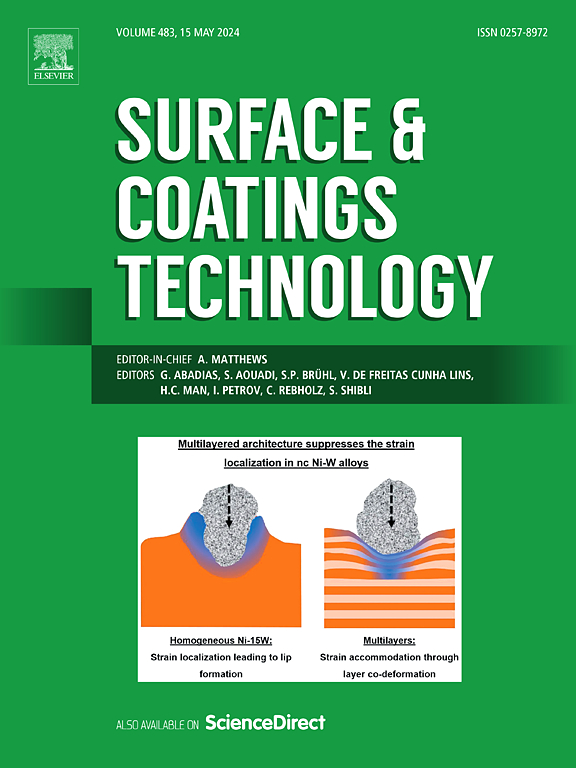多层铁基超细晶粒激光熔覆层的微观结构、机械性能和切割性能研究
IF 6.1
2区 材料科学
Q1 MATERIALS SCIENCE, COATINGS & FILMS
引用次数: 0
摘要
为了提高高速钢(HSS)刀具的切削性能,在刀具表面原位镀上1-3层vc增强铁基超细晶激光熔覆层。研究了熔覆层数对熔覆层宏观组织、相组成、显微组织、力学性能和切削性能的影响。结果表明:单层包层主要由α-Fe、γ、VC、Cr₇C₃、Cr₂₃C₆、WC和Mo2C相组成,而两层和三层包层主要由Fe₃C相组成。随着熔覆层数的增加,熔覆层中的VC颗粒由花瓣状向枝晶状转变。熔覆层晶粒逐渐细化,三层熔覆层的平均晶粒尺寸达到0.91 μm,达到亚微米级的超细晶尺度。第三层的平均显微硬度最高,为1055 HV0.2。使用三层熔覆层时,三层熔覆层的磨损疤痕宽度、深度和磨损体积均达到最小值,分别约为0.5 mm、1.11 μm和0.184 × 107 μm3。切削实验表明,与M2型高速钢刀具相比,三层熔覆层刀具的主切削力降低了8.6%,切削距离增加了73%。工件表面粗糙度最小达到2.5 Ra,刀具磨损方式为粘着磨损。本文章由计算机程序翻译,如有差异,请以英文原文为准。
Investigation of the microstructure, mechanical properties and cutting performance of multi-layer Fe-based ultrafine-grained laser cladding layers
To enhance the performance of high-speed steel (HSS) cutting tools, 1–3 layers of in situ VC-reinforced Fe-based ultrafine-grained laser cladding layers were applied to their surfaces. The effect of the number of cladding layers on the macrostructure, phase composition, microstructure, mechanical properties, and cutting performance of the cladding layers were investigated. The results indicated that the single-layer cladding layers consisted of α-Fe, γ, VC, Cr₇C₃, Cr₂₃C₆, WC and Mo2C phases, while the two-layer and three-layer claddings exhibited the presence of the Fe₃C phase. As the number of cladding layers increased, the VC particles in the cladding layers transitioned from a petal-like to a dendritic morphology. The cladding layer grains became finer, with the average grain size of the three-layer cladding layer reaching 0.91 μm, corresponding to the submicron ultrafine-grained scale. The third layer exhibited the highest average microhardness of 1055 HV0.2. When the three-layer cladding layer was applied, the wear scar width, depth, and wear volume of the three-layer cladding layers reached their minimum values, measuring approximately 0.5 mm, 1.11 μm, and 0.184 × 107 μm3, respectively. Cutting experiments demonstrated that, compared with the M2 HSS tool, the main cutting force of the three-layer cladding layer tool was reduced by 8.6 %, while the cutting distance was increased by 73 %. The workpiece surface roughness reached a minimum of 2.5 Ra, and the tool wear mode was adhesive wear.
求助全文
通过发布文献求助,成功后即可免费获取论文全文。
去求助
来源期刊

Surface & Coatings Technology
工程技术-材料科学:膜
CiteScore
10.00
自引率
11.10%
发文量
921
审稿时长
19 days
期刊介绍:
Surface and Coatings Technology is an international archival journal publishing scientific papers on significant developments in surface and interface engineering to modify and improve the surface properties of materials for protection in demanding contact conditions or aggressive environments, or for enhanced functional performance. Contributions range from original scientific articles concerned with fundamental and applied aspects of research or direct applications of metallic, inorganic, organic and composite coatings, to invited reviews of current technology in specific areas. Papers submitted to this journal are expected to be in line with the following aspects in processes, and properties/performance:
A. Processes: Physical and chemical vapour deposition techniques, thermal and plasma spraying, surface modification by directed energy techniques such as ion, electron and laser beams, thermo-chemical treatment, wet chemical and electrochemical processes such as plating, sol-gel coating, anodization, plasma electrolytic oxidation, etc., but excluding painting.
B. Properties/performance: friction performance, wear resistance (e.g., abrasion, erosion, fretting, etc), corrosion and oxidation resistance, thermal protection, diffusion resistance, hydrophilicity/hydrophobicity, and properties relevant to smart materials behaviour and enhanced multifunctional performance for environmental, energy and medical applications, but excluding device aspects.
 求助内容:
求助内容: 应助结果提醒方式:
应助结果提醒方式:


